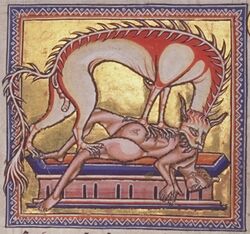Unsolved:Werehyena
This article or section possibly contains synthesis of material which does not verifiably mention or relate to the main topic. (December 2012) (Learn how and when to remove this template message) |
Were-hyena is a neologism coined in analogy to werewolf for therianthropy involving hyenas. It is common in the folklore of North Africa, the Horn of Africa and the Near East, as well as some adjacent territories. Unlike werewolves and other therianthropes, which are usually portrayed as being originally human, some werehyena lore tells of how they can also be hyenas disguised as humans.[1]
African cultures
In Somalia, it is traditionally believed that Qori Ismaris ("One who rubs himself with a stick") was a man who could transform himself into a "Hyena-man" by rubbing himself with a magic stick at nightfall and by repeating this process could return to his human state before dawn.
Also in Ethiopia, it is traditionally believed that every blacksmith, whose trade is hereditary, is really a wizard or witch with the power to change into a hyena. These blacksmith werehyenas are believed to rob graves at midnight and are referred to as bouda[1] (also spelled buda).[2][3] They are viewed with suspicion by most countrymen. Belief in the bouda is also present in Sudan, Tanzania and Morocco where some among the Berber people regard the bouda as a man or woman who nightly turns into a hyena and resumes human shape at dawn.[1] Many Ethiopian Christians characterize Ethiopian Jews as being bouda, accusing them of unearthing Christian corpses and consuming them; the commonality of blacksmithing as a traditional profession for Jewish men in Ethiopia may be a reason for the connection between the two beliefs.[3]
In the Kanuri language of the former Bornu Empire in the Lake Chad region, werehyenas are referred to as bultungin which translates into "I change myself into a hyena".[2] It was once traditionally believed that one or two of the villages in the region was populated entirely by werehyenas,[1] such as Kabultiloa.[4]
In the folklore of western Sudanic peoples, there is a hybrid creature, a human who is nightly transformed into a cannibalistic monster that terrorizes people, especially lovers. The creature is often portrayed as a magically powerful healer, blacksmith, or woodcutter in its human form, but recognizable through signs like a hairy body, red and gleaming eyes and a nasal voice.[5]
Members of the Korè cult of the Bambara people in Mali “become” hyenas by imitating the animals' behaviour through masks and roleplays. These are evocative of the hyenas' reviled habits, and may also be used to evoke fear among the participants, leading them to avoid such habits and traits in their own lives.[5]
Other cultures
Al-Doumairy, in his Hawayan Al-Koubra (1406), wrote that hyenas are vampiric creatures that attack people at night and suck the blood from their necks. Arab folklore tells of how hyenas can mesmerise victims with their eyes or sometimes with their pheromones.[6]
A Persian medical treatise written in 1376 tells how to cure people known as kaftar, who are said to be “half-man, half-hyena,” who have the habit of slaughtering children.[5]
The Greeks, until the end of the 19th century, believed that the bodies of werewolves, if not destroyed, would haunt battlefields as vampiric hyenas which drank the blood of dying soldiers.[1]
Films
- The Heart's Cry – 1994
- Hyenas (film) - 2011
- Anchorman 2: The Legend Continues – 2013
Video games
See also
- Blood libel
- Crocotta
- Cynanthropy
- Gnoll
- Leopard Society
- Lycanthropy (disambiguation)
- Shapeshifting
- Skin-walker
- Therianthropy
- Were
- Werecat
- Wererat
- Werewolf
- "The Pack", an episode of Buffy the Vampire Slayer that featured creatures similar to the werehyena
References
- ↑ 1.0 1.1 1.2 1.3 1.4 Woodward, Ian (1979). The Werewolf Delusion. p. 256. ISBN 0-448-23170-0.
- ↑ 2.0 2.1 Tylor, Edward Burnett (1920). Primitive culture. John Murray. p. 301. https://archive.org/details/in.ernet.dli.2015.90248.
- ↑ 3.0 3.1 Salamon, Hagar (1999). The Hyena People: Ethiopian Jews in Christian Ethiopia. ISBN 0-520-21901-5.
- ↑ Massey, Gerald (2007). The Natural Genesis – Vol.1. Cosimo, Inc.. p. 73. ISBN 1-60206-084-3.
- ↑ 5.0 5.1 5.2 "The Magicality of the Hyena: Beliefs and Practices in West and South Asia". Asian Folklore Studies, Volume 57, 1998: 331–344. June 2008. Archived from the original on 2008-06-25. https://web.archive.org/web/20080625072539/http://www.nanzan-u.ac.jp/SHUBUNKEN/publications/afs/pdf/a1246.pdf. Retrieved 23.
- ↑ Mounir R. Abi-Said (2006). Reviled as a grave robber: The ecology and conservation of striped hyenas in the human dominated landscapes of Lebanon.
External links
- Book Review: The Hyena People: Ethiopian Jews In Christian Ethiopia


